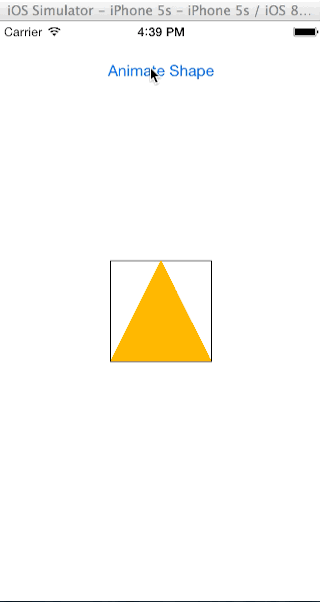Animate CAShapeLayer path on animated bounds change
Solution 1
I know this is an old question but I can provide you a solution which appears similar to Mr Lockwoods approach. Sadly the source code here is swift so you will need to convert it to ObjC.
As mentioned before if the layer is a backing layer for a view you can intercept the CAAction's in the view itself. This however isn't convenient for example if the backing layer is used in more then one view.
The good news is actionForLayer:forKey: actually calls actionForKey: in the backing layer.
It's in the actionForKey: in the backing layer where we can intercept these calls and provide an animation for when the path is changed.
An example layer written in swift is as follows:
class AnimatedBackingLayer: CAShapeLayer
{
override var bounds: CGRect
{
didSet
{
if !CGRectIsEmpty(bounds)
{
path = UIBezierPath(roundedRect: CGRectInset(bounds, 10, 10), cornerRadius: 5).CGPath
}
}
}
override func actionForKey(event: String) -> CAAction?
{
if event == "path"
{
if let action = super.actionForKey("backgroundColor") as? CABasicAnimation
{
let animation = CABasicAnimation(keyPath: event)
animation.fromValue = path
// Copy values from existing action
animation.autoreverses = action.autoreverses
animation.beginTime = action.beginTime
animation.delegate = action.delegate
animation.duration = action.duration
animation.fillMode = action.fillMode
animation.repeatCount = action.repeatCount
animation.repeatDuration = action.repeatDuration
animation.speed = action.speed
animation.timingFunction = action.timingFunction
animation.timeOffset = action.timeOffset
return animation
}
}
return super.actionForKey(event)
}
}
Solution 2
I think you have problems because you play with the frame of a layer and it's path at the same time.
I would just go with CustomView that has custom drawRect: that draws what you need, and then just do
[UIView animateWithDuration:1.0 delay:0.0 usingSpringWithDamping:0.3 initialSpringVelocity:0.0 options:0 animations:^{
self.customView.bounds = newBounds;
} completion:nil];
Sor the is no need to use pathes at all
Here is what i've got using this approach https://dl.dropboxusercontent.com/u/73912254/triangle.mov
Solution 3
Found solution for animating path of CAShapeLayer while bounds is animated:
typedef UIBezierPath *(^PathGeneratorBlock)();
@interface AnimatedPathShapeLayer : CAShapeLayer
@property (copy, nonatomic) PathGeneratorBlock pathGenerator;
@end
@implementation AnimatedPathShapeLayer
- (void)addAnimation:(CAAnimation *)anim forKey:(NSString *)key {
if ([key rangeOfString:@"bounds.size"].location == 0) {
CAShapeLayer *presentationLayer = self.presentationLayer;
CABasicAnimation *pathAnim = [anim copy];
pathAnim.keyPath = @"path";
pathAnim.fromValue = (id)[presentationLayer path];
pathAnim.toValue = (id)self.pathGenerator().CGPath;
self.path = [presentationLayer path];
[super addAnimation:pathAnim forKey:@"path"];
}
[super addAnimation:anim forKey:key];
}
- (void)removeAnimationForKey:(NSString *)key {
if ([key rangeOfString:@"bounds.size"].location == 0) {
[super removeAnimationForKey:@"path"];
}
[super removeAnimationForKey:key];
}
@end
//
@interface ShapeLayeredView : UIView
@property (strong, nonatomic) AnimatedPathShapeLayer *layer;
@end
@implementation ShapeLayeredView
@dynamic layer;
+ (Class)layerClass {
return [AnimatedPathShapeLayer class];
}
- (instancetype)initWithGenerator:(PathGeneratorBlock)pathGenerator {
self = [super init];
if (self) {
self.layer.pathGenerator = pathGenerator;
}
return self;
}
@end
Solution 4
I think it is out of sync between bounds and path animation is because different timing function between UIVIew spring and CABasicAnimation.
Maybe you can try animate transform instead, it should also transform the path (untested), after it finished animating, you can then set the bound.
One more possible way is take snapshot the path, set it as content of the layer, then animate the bound, the content should follow the animation then.
Ole Begemann
Updated on June 05, 2022Comments
-
 Ole Begemann almost 2 years
Ole Begemann almost 2 yearsI have a CAShapeLayer (which is the layer of a UIView subclass) whose
pathshould update whenever the view'sboundssize changes. For this, I have overridden the layer'ssetBounds:method to reset the path:@interface CustomShapeLayer : CAShapeLayer @end @implementation CustomShapeLayer - (void)setBounds:(CGRect)bounds { [super setBounds:bounds]; self.path = [[self shapeForBounds:bounds] CGPath]; }This works fine until I animate the bounds change. I would like to have the path animate alongside any animated bounds change (in a UIView animation block) so that the shape layer always adopts to its size.
Since the
pathproperty does not animate by default, I came up with this:Override the layer's
addAnimation:forKey:method. In it, figure out if a bounds animation is being added to the layer. If so, create a second explicit animation for animating the path alongside the bounds by copying all the properties from the bounds animation that gets passed to the method. In code:- (void)addAnimation:(CAAnimation *)animation forKey:(NSString *)key { [super addAnimation:animation forKey:key]; if ([animation isKindOfClass:[CABasicAnimation class]]) { CABasicAnimation *basicAnimation = (CABasicAnimation *)animation; if ([basicAnimation.keyPath isEqualToString:@"bounds.size"]) { CABasicAnimation *pathAnimation = [basicAnimation copy]; pathAnimation.keyPath = @"path"; // The path property has not been updated to the new value yet pathAnimation.fromValue = (id)self.path; // Compute the new value for path pathAnimation.toValue = (id)[[self shapeForBounds:self.bounds] CGPath]; [self addAnimation:pathAnimation forKey:@"path"]; } } }I got this idea from reading David Rönnqvist's View-Layer Synergy article. (This code is for iOS 8. On iOS 7, it seems that you have to check the animation's
keyPathagainst@"bounds"and not `@"bounds.size".)The calling code that triggers the view's animated bounds change would look like this:
[UIView animateWithDuration:1.0 delay:0.0 usingSpringWithDamping:0.3 initialSpringVelocity:0.0 options:0 animations:^{ self.customShapeView.bounds = newBounds; } completion:nil];Questions
This mostly works, but I am having two problems with it:
Occasionally, I get a crash on (Edit: never mind. I forgot to convertEXC_BAD_ACCESS) inCGPathApply()when triggering this animation while a previous animation is still in progress. I am not sure whether this has anything to do with my particular implementation.UIBezierPathtoCGPathRef. Thanks @antonioviero!When using a standard UIView spring animation, the animation of the view's bounds and the layer's path is slightly out of sync. That is, the path animation also performs in a springy way, but it does not follow the view's bounds exactly.
More generally, is this the best approach? It seems that having a shape layer whose path is dependent on its bounds size and which should animate in sync with any bounds changes is something that should just work™ but I'm having a hard time. I feel there must be a better way.
Other things I have tried
- Override the layer's
actionForKey:or the view'sactionForLayer:forKey:in order to return a custom animation object for thepathproperty. I think this would be the preferred way but I did not find a way to get at the transaction properties that should be set by the enclosing animation block. Even if called from inside an animation block,[CATransaction animationDuration] etc. always return the default values.
Is there a way to (a) determine that you are currently inside an animation block, and (b) to get the animation properties (duration, animation curve etc.) that have been set in that block?
Project
Here's the animation: The orange triangle is the path of the shape layer. The black outline is the frame of the view hosting the shape layer.

Have a look at the sample project on GitHub. (This project is for iOS 8 and requires Xcode 6 to run, sorry.)
Update
Jose Luis Piedrahita pointed me to this article by Nick Lockwood, which suggests the following approach:
Override the view's
actionForLayer:forKey:or the layer'sactionForKey:method and check if the key passed to this method is the one you want to animate (@"path").If so, calling
superon one of the layer's "normal" animatable properties (such as@"bounds") will implicitly tell you if you are inside an animation block. If the view (the layer's delegate) returns a valid object (and notnilorNSNull), we are.Set the parameters (duration, timing function, etc.) for the path animation from the animation returned from
[super actionForKey:]and return the path animation.
This does indeed work great under iOS 7.x. However, under iOS 8, the object returned from
actionForLayer:forKey:is not a standard (and documented)CA...Animationbut an instance of the private_UIViewAdditiveAnimationActionclass (anNSObjectsubclass). Since the properties of this class are not documented, I can't use them easily to create the path animation._Edit: Or it might just work after all. As Nick mentioned in his article, some properties like
backgroundColorstill return a standardCA...Animationon iOS 8. I'll have to try it out.` -
Henny Lee about 8 yearsCan you also translate this into Swift? I'm having trouble making this work in Swift.
-
 k06a about 8 years@HennyLee removed
k06a about 8 years@HennyLee removed@keypathusage with simple string constants. This should help to convert to Swift. -
Dong Ma almost 8 yearsI changed
actionForKeytoanimationForKey, and it works -
 Vin Gazoil about 4 yearsThank you so much for this! Works like a charm, even with spring animations by casting the
Vin Gazoil about 4 yearsThank you so much for this! Works like a charm, even with spring animations by casting theactiontoCASpringAnimation.